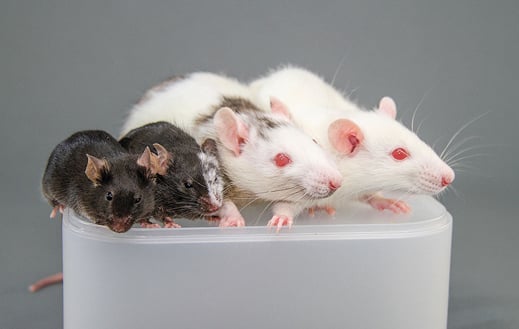Human-Animal Chimeras Are Gestating on U.S. Research Farms

Braving a funding ban put in place by America’s top health agency, some U.S. research centers are moving ahead with attempts to grow human tissue inside pigs and sheep with the goal of creating hearts, livers, or other organs needed for transplants.
The effort to incubate organs in farm animals is ethically charged because it involves adding human cells to animal embryos in ways that could blur the line between species.
Last September, in a reversal of earlier policy, the National Institutes of Health announced it would not support studies involving such “human-animal chimeras” until it had reviewed the scientific and social implications more closely.

The agency, in a statement, said it was worried about the chance that animals’ “cognitive state” could be altered if they ended up with human brain cells.
The NIH action was triggered after it learned that scientists had begun such experiments with support from other funding sources, including from California’s state stem-cell agency. The human-animal mixtures are being created by injecting human stem cells into days-old animal embryos, then gestating these in female livestock.
Based on interviews with three teams, two in California and one in Minnesota, MIT Technology Review estimates that about 20 pregnancies of pig-human or sheep-human chimeras have been established during the last 12 months in the U.S., though so far no scientific paper describing the work has been published, and none of the animals were brought to term.
The extent of the research was disclosed in part during presentations made at the NIH’s Maryland campus in November at the agency’s request. One researcher, Juan Carlos Izpisua Belmonte of the Salk Institute, showed unpublished data on more than a dozen pig embryo containing human cells. Another, from the University of Minnesota, provided photographs of a 62-day-old pig fetus in which the addition of human cells appeared to have reversed a congenital eye defect.
The experiments rely on a cutting-edge fusion of technologies, including recent breakthroughs in stem-cell biology and gene-editing techniques. By modifying genes, scientists can now easily change the DNA in pig or sheep embryos so that they are genetically incapable of forming a specific tissue. Then, by adding stem cells from a person, they hope the human cells will take over the job of forming the missing organ, which could then be harvested from the animal for use in a transplant operation.
“We can make an animal without a heart. We have engineered pigs that lack skeletal muscles and blood vessels,” says Daniel Garry, a cardiologist who leads a chimera project at the University of Minnesota. While such pigs aren’t viable, they can develop properly if a few cells are added from a normal pig embryo. Garry says he’s already melded two pigs in this way and recently won a $1.4 million grant from the U.S. Army, which funds some biomedical research, to try to grow human hearts in swine.
“The specter of an intelligent mouse stuck in a laboratory somewhere screaming ‘I want to get out’ would be very troubling to people.”
Because chimeras could provide a new supply of organs for needy patients and also lead to basic discoveries, researchers including Garry say they intend to press forward despite the NIH position. In November, he was one of 11 authors who published a letter criticizing the agency for creating “a threat to progress” that “casts a shadow of negativity” on their work.
The worry is that the animals might turn out to be a little too human for comfort, say ending up with human reproductive cells, patches of people hair, or just higher intelligence. “We are not near the island of Dr. Moreau, but science moves fast,” NIH ethicist David Resnik said during the agency’s November meeting. “The specter of an intelligent mouse stuck in a laboratory somewhere screaming ‘I want to get out’ would be very troubling to people.”
The chance of an animal gaining human consciousness is probably slim; their brains are just too different, and much smaller. Even so, as a precaution, researchers working with farm-animal chimeras haven’t yet permitted any to be born, but instead are collecting fetuses in order to gather preliminary information about how great the contribution of human cells is to the animals’ bodies.

Hiromitsu Nakauchi, a stem-cell biologist at Stanford University, began trying to make human-sheep chimeras this year. He says that so far the contribution by human cells to the animals’ bodies appears to be relatively small. “If the extent of human cells is 0.5 percent, it’s very unlikely to get thinking pigs or standing sheep,” he says. “But if it’s large, like 40 percent, then we’d have to do something about that.”
Other kinds of human-animal chimeras are already widely used in scientific research, including “humanized” mice endowed with a human immune system. Such animals are created by adding bits of liver and thymus from a human fetus (collected after an abortion) to a mouse after it is born.
The new line of research goes further because it involves placing human cells into an animal embryo at the very earliest stage, when it is a sphere of just a dozen cells in a laboratory dish. This process, called “embryo complementation,” is significant because the human cells can multiply, specialize, and potentially contribute to any part of the animal’s body as it develops.
In 2010, while working in Japan, Nakauchi used the embryo complementation method to show he could generate mice with a pancreas made entirely of rat cells. “If it works as it does in rodents,” he says, “we should be able have a pig with a human organ.”
“What if the embryo that develops is mostly human? It’s something that we don’t expect, but no one has done this experiment, so we can’t rule it out.”
Although Nakauchi was a star scientist, Japanese regulators were slow to approve his idea for chimeras—a “pig man” as critics put it—and by 2013 Nakauchi decided to move to the U.S., where no federal law restricts the creation of chimeras. Stanford was able to recruit him with the help of a $6 million grant from the California Institute of Regenerative Medicine, a state agency set up a decade ago to bypass political interference from Washington.
While the NIH funding ban doesn’t affect Nakauchi, it has put researchers under pressure to explain the purpose of their work. “I want to show you some chimeras,” Nakauchi said when I visited his laboratory at Stanford last month. He opened the door to a small room containing incubators where the chimeric embryos are stored. Because an early embryo is almost invisible to the human eye, the room houses special microscopes equipped with micro-needles used to inject the human cells into them.
The type of human cells being added are called iPS cells, made from skin or blood chemically reprogrammed into more versatile stem cells using a Nobel Prize-winning formula developed by one of Nakauchi’s Japanese colleagues. Nakauchi says that as a matter of convenience, most of the iPS cells his team has been placing into animal embryos are made from his own blood, since recruiting volunteers involves too much paperwork.
“We need a special consent if we’re injecting into animals,” he says sheepishly. “So I try to use my own.”

The word chimera comes from the creature of Greek myth, part lion, part goat, and part snake. Nakauchi says most people at first imagine his chimeras are monsters, too. But he says attitudes change if he can explain his proposal. One reason is that if his iPS cells develop inside an animal, the resulting tissue will actually be his, a kind of perfectly matched replacement part. Desperately ill people on organ waiting lists might someday order a chimera and wait less than a year for their own custom organ to be ready. “I really don’t see much risk to society,” he says.
Before that can happen, scientists will have to prove that human cells can really multiply and contribute effectively to the bodies of farm animals. That could be challenging since, unlike rats and mice, which are fairly close genetically, humans and pigs last shared an ancestor nearly 90 million years ago.
To find out, researchers in 2014 decided to begin impregnating farm animals with human-animal embryos, says Pablo Ross, a veterinarian and developmental biologist at the University of California, Davis, where some of the animals are being housed. Ross says at Davis he has transferred about six sets of pig-human embryos into sows in collaboration with the Salk Institute and established another eight or 10 pregnancies of sheep-human embryos with Nakauchi. Another three dozen pig transfers have taken place outside the U.S., he says.
These early efforts aren’t yet to make organs, says Ross, but more “to determine the ideal conditions for generating human-animal chimeras.” The studies at Davis began only after a review by three different ethics committees, and even then, he says, the university decided to be cautious and limit the time the animals would be allowed to develop to just 28 days (a pig is born in 114 days).
By then, the embryonic pig is only half an inch long, though that’s developed enough to check if human cells are contributing to its rudimentary organs.
“We don’t want to grow them to stages we don’t need to, since that would be more controversial,” says Ross. “My view is that the contribution of human cells is going to be minimal, maybe 3 percent, maybe 5 percent. But what if they contributed to 100 percent of the brain? What if the embryo that develops is mostly human? It’s something that we don’t expect, but no one has done this experiment, so we can’t rule it out.”
Deep Dive
Biotechnology and health
How scientists traced a mysterious covid case back to six toilets
When wastewater surveillance turns into a hunt for a single infected individual, the ethics get tricky.
An AI-driven “factory of drugs” claims to have hit a big milestone
Insilico is part of a wave of companies betting on AI as the "next amazing revolution" in biology
The quest to legitimize longevity medicine
Longevity clinics offer a mix of services that largely cater to the wealthy. Now there’s a push to establish their work as a credible medical field.
There is a new most expensive drug in the world. Price tag: $4.25 million
But will the latest gene therapy suffer the curse of the costliest drug?
Stay connected
Get the latest updates from
MIT Technology Review
Discover special offers, top stories, upcoming events, and more.